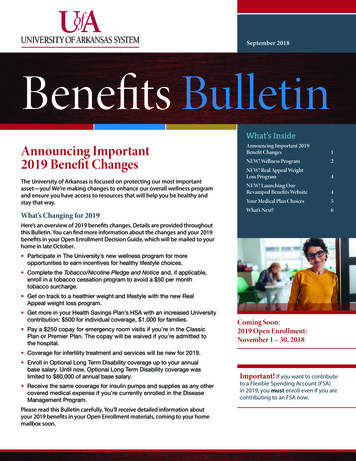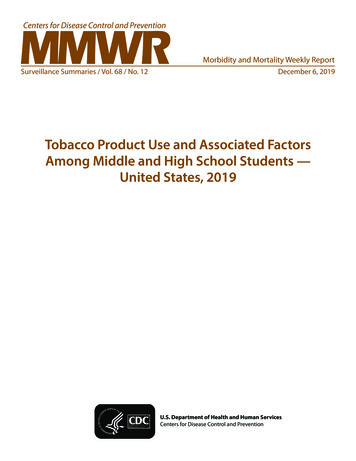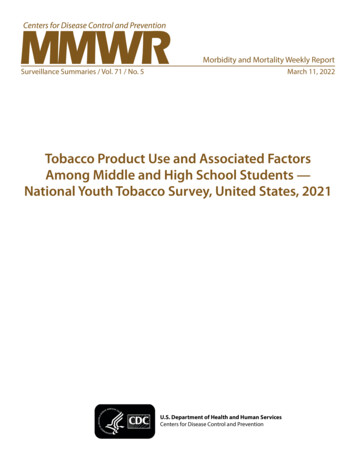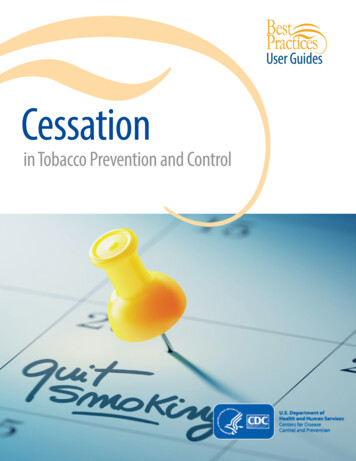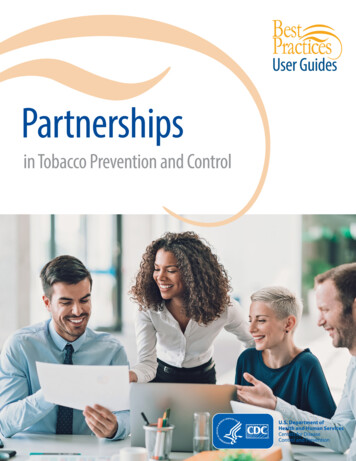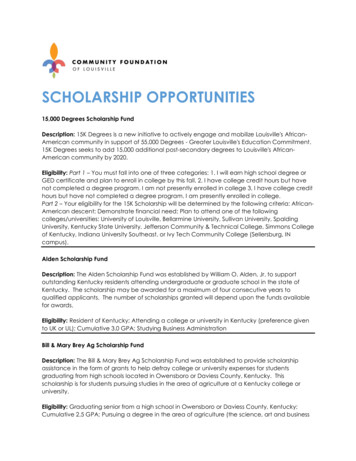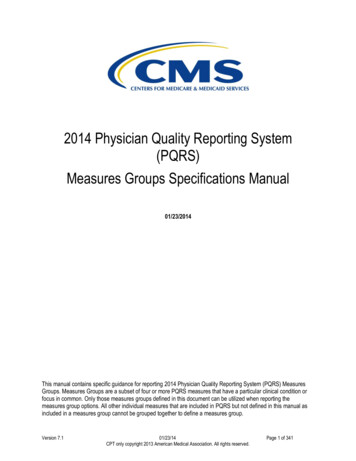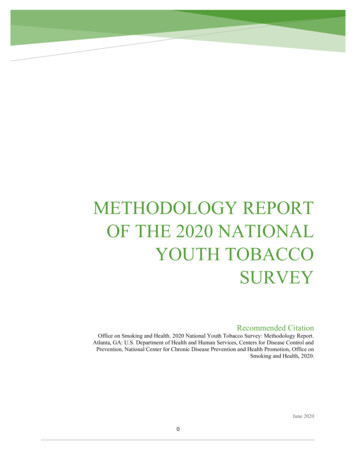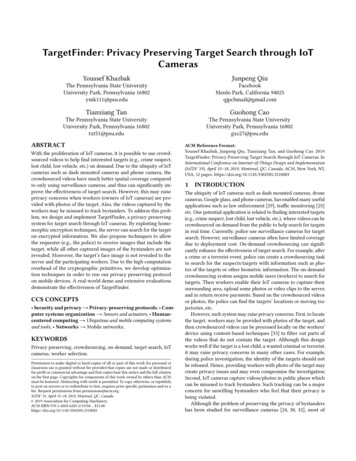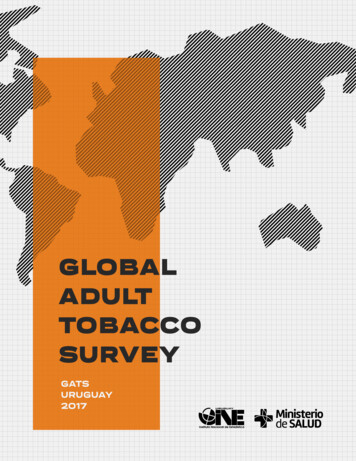
Transcription
Pennsylvania Tobacco Preventionand Control Program 2018–2022
ContentsForeword. . . . . . . . . . . . . . . . . . . . . . . . . . . . . . . . . . . . . . . . . . . . . . . . . . . . . . . .1Best Practices . . . . . . . . . . . . . . . . . . . . . . . . . . . . . . . . . . . . . . . . . . . . . . . . . . .2Issues . . . . . . . . . . . . . . . . . . . . . . . . . . . . . . . . . . . . . . . . . . . . . . . . . . . . . . . . . .4GOALS, STRATEGIES AND ACTION STEPSGoal 1: Prevent initiation of tobacco use among youthand young adults . . . . . . . . . . . . . . . . . . . . . . . . . . . . . . . . . . . . . . . . . . . . .7Goal 2: Promote cessation efforts among adults and youthto address use of all tobacco products . . . . . . . . . . . . . . . . . . . . . . . . . .10Goal 3: Eliminate exposure to secondhand smoke. . . . . . . . . . . . . . . . . 12Goal 4: Identify and eliminate tobacco and all othertobacco products disparities . . . . . . . . . . . . . . . . . . . . . . . . . . . . . . . . . .13Goal 5: Enhance Pennsylvania’s role as a nationally recognizedleader in tobacco control programs and policies . . . . . . . . . . . . . . . . . .14Appendix—Charts . . . . . . . . . . . . . . . . . . . . . . . . . . . . . . . . . . . . . . . . . . . . . . .15References . . . . . . . . . . . . . . . . . . . . . . . . . . . . . . . . . . . . . . . . Inside Back Cover
ForewordThis strategic plan for Pennsylvania’s Tobacco Prevention and Control Program2018–2022 represents a coordinated effort between the Pennsylvania Departmentof Health (PA DOH), key partners and other stakeholders in tobacco prevention andcontrol in Pennsylvania. The strategic plan for tobacco prevention and control is reflective of astatewide assessment of current trends and activities, as well as defining new and emergingpublic health priorities. In addition, the strategic plan defines a roadmap for the next five yearsto significantly decrease tobacco-related morbidity, mortality, and related economic costs inPennsylvania. By collaborating with our partners to enact this plan, resources can be leveragedto raise awareness, provide comprehensive programs, and improve health equity.The strategic plan identifies strategies to address these five goals: PREVENT initiation of all tobacco product use among youth and young adults;PROMOTE cessation efforts among adults and youth to address all tobacco product use;ELIMINATE exposure to secondhand smoke;IDENTIFY AND ELIMINATE all tobacco product disparities; andENHANCE Pennsylvania’s role as a nationally recognized leader in tobacco controlprograms and policies.This plan will serve as the framework to inform program goals and activities throughoutthe Commonwealth. The shared goals and initiatives will foster a comprehensive tobaccocontrol program from which all organizations with vested interest can benefit. Dynamic andcoordinated program planning and implementation ensures sustained and positive action.1
Best PracticesMaking the Case for Health Equity in Public Health1HealthHealth equity is the opportunity for everyone to reach theirand HealthCarefull health potential, regardless of any socially determinedcircumstance. Health equity can be achieved in tobaccoSocial andNeighborhoodprevention and control by eliminating differencesand BuiltCommunitySocialin tobacco use and exposure to secondhandEnvironmentContentDeterminantssmoke between certain groups. Well-enforced andof Healthcomprehensive tobacco control policies (i.e., thosenot including exceptions or unclear language leavingsome population groups unprotected) can reduce theseEconomicdisparities. Unlike traditional direct-service interventionsEducationStabilityfocusing on individual behaviors, tobacco control policiesfocus on large-scale, population-level changes. They have thepotential to influence and change social norms related to tobaccoSource: Healthy People 2020initiation, use, and secondhand smoke exposure.Comprehensive tobacco control policies help achieve health equity by reducing disparitiesamong groups most affected by tobacco use and secondhand smoke exposure. Multiple,coordinated efforts can reduce tobacco related disparities among groups with the highestrates of use and secondhand smoke exposure. These efforts can include implementingcomprehensive smokefree laws, increasing tobacco product prices, reducing targetedtobacco industry advertising, and offering comprehensive cessation services (i.e., includingall seven FDA-approved cessation medications along with individual, group, and telephonecounseling). Comprehensive policies can reduce smoking initiation, tobacco use, andexposure to secondhand smoke.Addressing the Factors that Influence Tobacco-Related Disparities2Tobacco-related disparities are created and affected by a complex mix of factors, includingsocial determinants of health, which include: the conditions in which people are born, grow,live, work and age; tobacco industry influence; a changing U.S. population; and a lack ofcomprehensive tobacco control policies. Differences in health achievement do not have asingle or simple solution. Comprehensive, well-enforced policies help address these factorsby changing social norms about tobacco use, increasing protections against exposure tosecondhand smoke, and improving access to cessation resources among populations facingthe greatest burden of tobacco use and exposure.2
Creating a Return on Investment3Tobacco control policies are a cost-effective way to reduce the health care costs of tobaccouse and secondhand smoke exposure. Tobacco control programs can increase their returnon investment when populations experiencing tobacco-related disparities are protected bycomprehensive policies. Because populations experiencing health disparities make up asignificant portion of healthcare costs, policies focused on protecting these groups have thepotential to significantly reduce overall health care costs.Building Support for Tobacco Control Among Diverse Parts of the Community4Policies are interventions which can provide broad community support. Participation from avariety of stakeholders creates a powerful force that can work to eliminate tobacco-relateddisparities and achieve health equity. For example, coalition efforts can increase awarenessof social and cultural differences, challenges facing specific populations, the harms oftobacco use, and the importance of comprehensive tobacco control programs. Whendeveloping, implementing, and enforcing tobacco control policies, coalitions can create thesustainable partnerships needed to reduce tobacco use and secondhand smoke exposure inthese communities.3
IssuesTobacco Control in PennsylvaniaPolicy PrioritiesMore than 50 years have passed since the 1964 Surgeon General’s report5 on Smokingand Health, but tobacco use remains the leading cause of preventable death and diseasenationwide, accounting for more deaths than alcohol, AIDS, vehicle fatalities, illegal drugs,murders, and suicides combined.6 In Pennsylvania, 18 percent of adults (PA BRFSS, 2016)and 13 percent of high school students are current smokers (YRBS, 2015), representing acombined 1.9 million current smokers.7Cigarette smoking causes 22,000 deaths each year in Pennsylvania.8 In addition to thesefatalities, smoking leads to increased rates of heart disease, stroke, and emphysema, andlifelong health impacts stemming from smoking-related preterm deliveries, stillbirths,and low birth weights.9 Exposure to secondhand smoke also poses serious health threats,4
including heart disease, lung cancer, and stroke among adults; and asthma attacks,bronchitis and pneumonia, and sudden infant death syndrome (SIDS) among children.10In fact, the Centers for Disease Control and Prevention (CDC) agrees that there is no safelevel of exposure to secondhand smoke.11 In Pennsylvania, non-smokers continue to beexposed to life-threatening secondhand smoke at thousands of public spaces across theCommonwealth, such as bars, restaurants and parks. The risks of secondhand smoke areparticularly acute for children living with smokers.Tobacco also has a significant negative impact on Pennsylvania’s economy. Annually,cigarette smoking costs Pennsylvania more than 14 billion in healthcare expenses and lostproductivity.12 While these costs are shared across various stakeholders, they impact allPennsylvanians; smoking-related government expenditures increase the state and federaltax burden by an average of 1,023 per household.13Successful implementation of the Strategic Plan for a Comprehensive Tobacco ControlProgram in Pennsylvania (2018–2022) provides the framework to help protectPennsylvania’s youth from the adverse health impacts of tobacco. This is a criticalcomponent of tobacco control, reducing non-smokers’ exposure to secondhand smoke, andbetter assisting current smokers to successfully quit using tobacco. The costs of tobacco useare high in life lost, quality of life, and in cash. Annual health care costs directly caused bysmoking in Pennsylvania alone amount to 6.38 billion.14Working with decision makers and elected officials is critical to protecting Pennsylvaniansfrom the harmful impacts of tobacco use. Comprehensive and evidence-based programs andpractices will be considered when working with decision makers to address the followingpublic policies: Comprehensive Clean Indoor Air LegislationRemove exemptions from the Pennsylvania Clean Indoor Air Act (CIAA), extending fullprotection from the effects of secondhand smoke to all Pennsylvania workers. Removepreemption from CIAA, enabling any locality to adopt and enforce indoor air regulationsthat set higher standards than the existing state law to include electronic nicotinedelivery systems (ENDS). E-cigarettes and Other Tobacco ProductsRecognize the potential health risks of electronic and other tobacco products and focuson tobacco-free and nicotine-free policies and regulations rather than solely smokefreepolicies and regulations. Insurance Coverage for Tobacco CessationAdopt legislative or regulatory standards for comprehensive smoking cessationtreatment coverage by insurance companies and Medicaid programs in Pennsylvania.5
Master Settlement Agreement (MSA) with the Tobacco IndustryAllocate funding for comprehensive tobacco control at the levels recommended by theCDC to meet the needs of Pennsylvanians ( 140 million annually). In exchange, thecompanies agreed to curtail or cease certain tobacco marketing practices, as well as topay, in perpetuity, various annual payments to the states to compensate them for someof the medical costs of caring for persons with smoking-related illnesses. The industryagreed to pay a minimum of 206 billion over the first 25 years of the agreement.In 1998, Pennsylvania and 45 other states entered an MSA with the tobacco industry.The MSA was estimated at 206 billion dollars nationwide. Pennsylvania was allottedan estimated 11 billion dollars to be disbursed in perpetuity from 2000 to 2025.Between July 2016 and June 2017, Pennsylvania will receive approximately 354million in MSA funding.Tobacco cessation and prevention funding for FY 17 comprises 13.7 million from theMSA and 3.07 million in federal funding, for a total of 16.77 million. This representsjust under 12 percent of the CDC-recommended spending level of 140 million. Raise the Legal Age of Sale for Tobacco Products in Pennsylvania to 21Increase the minimum legal age of sale (MLA) to 21 to significantly reduce youth tobaccouse and to prevent related disease and premature death among younger generations. Tax Non-Cigarette Tobacco Products at 40 Percent WholesaleCreate tax parity, with cigarettes, on all other tobacco products, including cigars, (usingpercentage of wholesale price) to prevent youth from initiating or switching use dueto an uneven tax regime. We applaud the legislature’s decision in 2017 to increasecigarette taxes and to join the rest of the country by implementing a first-time tax onother tobacco products, such as smokeless androll-your-own tobacco. This new tax will preventthousands of young Pennsylvanians frombecoming addicted to tobacco, and will saveour state millions of dollars in averted healthcare expenditures and lost productivity. However,Pennsylvania missed an opportunity to fully protectresidents from the health harms of tobacco by introducingthe tax as a weight-based tax on smokeless and roll-your-owntobacco, and by not taxing cigars. Pennsylvania remains one of onlytwo states that do not tax cigars.6
Goals, Strategies and Action StepsGOAL 1Prevent initiation of tobacco use among youthand young adultsStrategy: Reduce youth availability and access to tobacco products andelectronic nicotine delivery devices (ENDS), such as e-cigarettes, e-hookah,chewing tobacco, snuff, and snusAs evidenced by: Reduce the Pennsylvania Synar rate to less than 5% by 2022.Implementation of at least two recommended/model statewide tobacco control policies (e.g.,comprehensive CIAA, increased minimum purchase age to 21, increased tobacco tax).ACTION STEPS1. Raise the minimum age to purchase tobacco products in Pennsylvania to 21.2. Continue to monitor and enforce current youth access laws (e.g., Act 112, FDAcompliance checks).3. Create tax parity, with cigarettes, on all other tobacco products, including cigars, usingpercentage of wholesale price to prevent youth from initiating or switching use due toan uneven tax regime.4. Provide updated merchant education materials to include use of tobacco and all othertobacco products.5. Implement and enforce point-of-sale restrictions in targeted communities.6. Continue to collect data on sales to minors and enforcement of compliance checks.7. Strengthen clean indoor air laws by closing protection gaps.8. Expand current partnerships to include outreach to groups such as: PTO’s, PTA’s,Athletic Booster Clubs, and Health Centers to educate and inform policymakers of theimportance of proven tobacco policies.7
Strategy: Reduce demand for all tobacco products and ENDS among youthand young adultsAs evidenced by: Decrease the prevalence of cigarette smoking among young adults (18–29)from 18% (2015) to 14% by 2022 (BRFSS). Decrease the percent of high school studentswho smoked cigarettes on one or more of the last 30 days from 12.9% (2015) to 9% by 2022(YRBS). Decrease the percent of high school students who ever used e-cigarettes, e-cigars, orother electronic vaping products from 40.8% (2015) to 25% (2022) (YRBS).ACTION STEPS1. Support pricing policies that discourage use of all tobacco products use throughcommunity and youth engagement and to include youth empowerment opportunities(e.g., legislative visits, community mobilization, school-based health centers, PTO/PTA,booster clubs).2. Create tax equity between cigarettes and all other tobacco products using a percent ofwholesale tax structure.3. Continue youth-focused surveillance (e.g., YTS, YRBS).Strategy: Reduce tobacco industry influence on youth and young adultsAs evidenced by: Increase the percent of high school students who never smoked even a puffor two from 65.1% (2015) to 75% by 2022 (YRBS).ACTION STEPS1. Identify ways to reach youth and young adults with positive messages, informed byyouth themselves.2. Educate youth on tobacco industry influences and practices (e.g., targeting).3. Expand current partnerships to include outreach to groups such as: PTO’s, PTA’s,booster clubs, and Health Centers to educate and inform policy makers of theimportance of proven tobacco policies.4. Identify tobacco industry strategies to formulate effective program/advocacymessaging (e.g., counter-marketing using paid and earned media).5. Develop and implement a statewide youth-empowerment program that utilizes socialmedia and peer-to-peer education through TRU.6. Implement and enforce a point-of-sale (POS) policy that restricts sale of all tobaccoproducts near schools.8
Strategy: Assist schools, communities and organizations to implementevidence-based programming and policiesAs evidenced by: Increase the percent of schools that prohibit all tobacco use at all times inall locations from 60.4% (2014) to 75% by 2022 (CDC School Profile).ACTION STEPS1. Support and provide technical assistance for tobacco-free and all other tobaccoproducts free environments for all youth and young adults (e.g., 100% tobacco-freeschools, Young Lungs at Play, home policies, worksite policies).2. Update current 100% tobacco-free school policies to include all other tobaccoproducts. Continue to educate state-level school stakeholders, organizations, and localschool administrators and policy makers about the importance of 100% tobacco-freeschool policies.3. Provide resources to stakeholders about selecting and implementing evidenced-basedprevention programs.9
GOAL 2Promote cessation efforts among adults andyouth to address use of all tobacco productsStrategy: Increase access to comprehensive tobacco-cessation programs foradults and youthThe U.S. Public Health Service’s Treating Tobacco Use and Dependence Clinical PracticeGuideline recommends seven medications and three types of counseling that arescientifically proven to be effective in helping smokers quit. The Guideline, updated in 2008,is a review of decades of research on tobacco cessation, and is widely regarded as thedefinitive report on effective methods for treating tobacco users.As evidenced by: Increase the percent of adult smokers who quit smoking at least one day inthe past year from 53% (2015) to 70% by 2022 (BRFSS).ACTION STEPS1. Promote and market the PA Quitline (1-800-QUIT-NOW), PA QuitLogixPA, andFree Quitline online.2. Continue to provide and promote local and statewide cessation programs withNicotine replacement therapy (NRT)/pharmacotherapy, as appropriate (including thePA Free Quitline).3. Collaborate with partners to educate current administration and policy makers aboutthe importance and benefits of funding tobacco cessation programs.4. Integrate current cessation aids/resources and assisted referrals (e.g., text to quit,websites, online quit coach, electronic medical record (EMR)-assisted reminders) intocessation programming.5. Track quit success and NRT/pharmacological distribution among participants incessation/tobacco treatment programs.6. Enhance efforts to educate current partners within Pennsylvania to include: Medicaid,Medicare, PA Insurance Commission, and behavioral and mental health partnerships.10
Strategy: Increase the proportion of healthcare providers who routinelyadvise patients about cessation services and provide follow-upAs evidenced by: Increase the percent of current smokers who were advised to quit smokingby doctor, nurse or other health professional four or more times in the past year from 28%(2015) to 40% by 2022 (BRFSS).ACTION STEPS1. Provide cessation resource materials to physicians including: listing of local andregional service providers, Quitline and Quitlogix and Centers for Disease Controlresources.2. Educate healthcare providers on referral and education of patients (e.g., “Ask. Advise.Refer,” AAR and other brief interventions).3. Provide opportunities to work with healthcare providers (e.g., PA QuitLogix, NRTinitiatives).4. Increase the number of healthcare providers and institutions that adopt U.S. PublicHealth Service’s Treating Tobacco Use and Dependence Clinical Practice Guideline.5. Develop cessation education component in coordination with Annual Medical Education(AME) opportunities and similar continuing education requirements.Strategy: Promote comprehensivesmoking/tobacco cessation coveragefor all citizensAs evidenced by: Increase the grade ontobacco prevention and cessation fundingcoverage from the 2017 grade of an F to an Aby 2022 in the American Lung Association’sState of Tobacco Control Report.ACTION STEPS1. Secure support for comprehensivecessation coverage for private/publicinsurance and Medicaid.2. Monitor and address barriers tocessation access.3. Collaborate with private insurersand Medicaid providers to ensurecomprehensive smoking cessationis included on all policies, not amere option.11
GOAL 3Eliminate exposure to secondhand smokeStrategy: Strengthen and enforce policies that protect citizens fromexposure to secondhand and third-hand smokeAs evidenced by: Decrease the number of application-based Clean Indoor Air Act (CIAA)exemptions from 2,323 (Dec. 2016) to zero by 2022 (PA DOH).ACTION STEPS1. Reduce exposure to secondhand smoke by strengthening current clean indoor air law.2. Promote and support organizational, community and statewide comprehensivetobacco-free policies that include all other tobacco products for preventing exposureto secondhand smoke (e.g., tobacco-free housing, smoke-free homes, work siteinitiatives).3. Create support for comprehensive tobacco-free policies (which includes all othertobacco products) by educating healthcare providers, policy makers, general public,etc., about the health and economic benefits of tobacco-free environments.4. Evaluate the effectiveness and reach of tobacco-free policies and current protectioncoverage and gaps.5. Secure funding for enforcement efforts.6. Provide adequate resources/tools to promote tobacco-free environments (e.g.,communications materials, signage).7. Monitor enforcement efforts and identify and address gaps in enforcement.12
GOAL 4Identify and eliminate tobacco and all othertobacco products disparitiesStrategy: Incorporate efforts to achieve health equity in all areas of acomprehensive tobacco control programAs evidenced by: Elimination of negative significant differences in smoking prevalence acrossracial, ethnic, sexual orientation, education, and urban/rural groups by 2022 (BRFSS).ACTION STEPS1. Use evaluation and surveillance data to identify disparities and knowledge gaps sothat tailored messages, programs, and collaborative partnerships can be developed toaddress those disparities (e.g., demographic and geographic disparities) including:(a) People with chronic disease (e.g., diabetes, asthma)(b) Rural/urban populations(c) Low socioeconomic status (SES) (i.e., insurance status, education)(d) Age-based targets (youth, seniors, etc.)(e) Racial and ethnic (Latino, African-American, e.g.) minorities(f) Lesbian, gay, bisexual, transgender, questioning community2. Educate markets targeted by thetobacco industry about deceptiveadvertising to decrease the culturalacceptability of tobacco use.13
GOAL 5Enhance Pennsylvania’s role as a nationallyrecognized leader in tobacco controlprograms and policiesStrategy: Increase the use of data to make real-time improvements inprogrammingAs evidenced by: Carry out coordinated program planning and goal-setting across statewide,regional, and strategic plans (work plans, evaluation plan, etc.). Hold a minimum of threecoalition-based discussions between 2018 and 2022 to modify and inform strategic planapproaches, as well as check in on progress.ACTION STEPS1. Maintain surveillance data collection and sharing (key outcome indicator reports).2. Review and recommend changes to program approaches at least annually.3. Coordinate evaluation plan with strategic and sustainability plans.4. Increase use of program-level data to inform program decision making.Strategy: Increase public availability of program and field informationAs evidenced by: Maintain Department of Health tobacco pages and PACT website withresource tool updates at least semi-annually.ACTION STEPS1. Coordinate data sharing, release and planning with partners.2. Publicize outcomes to community stakeholders (including media).3. Publish findings from program evaluations, research studies and surveys.4. Improve resources and web-based resource housing.5. Educate policymakers on program outcomes and direction.14
Appendix—ChartsCurrent Adult Smokers, PennsylvaniaAll AdultsYoung Adults ource: PA DOH, EDDIE BRFSS dataEveryday Adult Smokers, PennsylvaniaAll Adults35%Young Adults ce: PA DOH, EDDIE BRFSS data15
Current Adult Smokeless* Tobacco Users, PAAll Adults35%Young Adults ludes chewing tobacco, snuff or snusSource: PA DOH, EDDIE BRFSS dataCurrent and Everyday Adult Smokers,Pennsylvania35%Current SmokersEveryday Smokers30%25%20%15%10%5%0%2012Source: PA DOH, EDDIE BRFSS data162013201420152016
Current Adult Smokers, PA and NationalPennsylvaniaUnited s: CDC BRFSS; PA DOH BRFSS; NHISAdults who quit smoking at least 1 day in the pastyear (out of adults who smoke every day)80%70%60%Young Adults(18-29)50%All Adults40%30%20%10%0%2012201320142015Source: PA DOH, EDDIE BRFSS data17
Current PA Youth Cigarette Use, 201520%18%16%14%12%10%8%6%4%2%0%OverallMaleMiddle SchoolFemaleHigh SchoolSource: YTS, CDC STATECurrent PA Youth Smokeless* Tobacco Use, 201520%18%16%14%12%10%8%6%4%2%0%OverallMiddle School*Includes chewing tobacco, snuff, or dipSource: YTS, CDC STATE18MaleFemaleHigh School
PA HS students who have used e-cigarettes,e-cigars or other electronic vaping erSource: YRBS 2015FemaleIn past 30 days*Not for distributionCurrent Smokers by Age, 13201420152016Source: PA DOH, EDDIE BRFSS data19
Current Smokers by Race/Ethnicity, Pennsylvania35%White, non-HispanicBlack, 420152016Source: PA DOH, EDDIE BRFSS dataCurrent Smokers by Veteran Status, 0%20122013Source: PA DOH, EDDIE BRFSS data20201420152016
Adults who quit smoking at least 1 day in the pastyear (out of adults who smoke every day)All Adults80%Young Adults ce: PA DOH, EDDIE BRFSS dataCurrent Adult Smokers in PA Area by State35%30%25%WVOH20%PADEMD, NYNJ15%10%5%0%20122013201420152016Source: CDC STATE BRFSS data21
Current Adult Smokers by District, PA 201622%PhiladelphiaNorthwest20%Northeast20%North Central19%Allegheny19%18%South Central17%Southwest14%SoutheastSource: PA DOH, EDDIE BRFSS dataCIAA 201320152016Denied/Renewal 56424982337Source: PA DOH Clean Indoor Air Act Annual Legislative Reports(years run from Dec 1 of previous year to Nov 30)222014
Disparities in Current Smoking Prevalence Rates,PA 2016WhiteBlackRaceFemaleMaleSexCollege GradHigh School OnlyEducationNo Health CareCoverageHealth 0%Pennsylvania Tobacco Prevention and ControlMSA Funding 180CDC Total Recommended Program Costs 160 155.5 140.0Funding in Millions of 140 120 100 80 60 40 52.0 51.8 41.4 46.1 33.0MSA Funding 30.3 31.7 32.1 17.7 20 00720082008200920092010 14.7 13.9 14.2201020112011201220122013 7.020132014 13.8 13.8 14.1 15.820142015201520162016201720172018State Fiscal YearSources: PA DOH, Act 77 Annual Report, SFY2002 to SFY2008; PA DOH 2009-2010 Budget; PA DOH 2010-2011 Budget; PA Appropriations Committee 2011-2012 Budget; PA DOH 1/7/13 email; PACT email 7/17/13; PA Office of theBudget 2013-14 Mid-Year Budget Briefing; PA DOH email 7/18/2014; PACT email 2/10/16; PA DOH email 11/7/17.23
30% 50.0 40.020% 30.0 20.010% 10.0 0.02001 2002 2003 2004 2005 2006 2007 2008 2009 2010 2011 2012 2013 2014 2015 2016 2017Percent of Tobacco Sales to Minors (Synar)MSA Funding in Millions of 60.0PATPC MSA Funding vs.Percent of Tobacco Sales to Minors0%Fiscal YearPA TPC Funding% of Sales to MinorsSource: PA DOH, Annual Synar Report, 2009 to 2017; PA DOH, Bureau of Health Statistics and Research, Division of Tobacco Prevention and Control (PATPC), Pennsylvania Tobacco Facts, 2009-2010; PA DOH, Act 77 Annual Report, SFY2002 to SYF2009; PA DOH 2009-2010 Budget to 2017-2018 Budget.24
References1. Centers for Disease Control and Prevention. Best Practices for Comprehensive Tobacco Control Programs—2014.Atlanta, GA: US Dept of Health and Human Services, Centers for Disease Control and Prevention, National Centerfor Chronic Disease Prevention and Health Promotion, Office on Smoking and Health; /best-practices-health- equity/pdfs/bp-health-equity.pdf2. Whitehead M, Dahlgren G. Levelling Up (Part 1): A Discussion Paper on Concepts and Principles for TacklingSocial Inequities in Health. Copenhagen, Denmark: World Health Organization, Regional Office for Europe; 2006.3. Thomas S, Fayter D, Misso K, et al. Population tobacco control interventions and their effects on socialinequalities in smoking: systematic review. Tobacco Control. 2008;17(4):230-237.4. Dinno A, Glantz S. Tobacco control policies are egalitarian: a vulnerabilities perspective on clean indoor air laws,cigarette prices, and tobacco use disparities. Social Science & Medicine. 2009;68(8):1439- 1447.5. Garrett BE, Dube SR, Winder C, Caraballo RS. Cigarette smoking in the United States, 2006-2008 and 20092010. MMWR Morbidity and Mortality Weekly Report. 2013;62(03) (suppl);81-84.6. Reducing tobacco use and secondhand smoke exposure: smokefree policies. The Guide to CommunityPreventative Services website. policies.html. UpdatedSeptember 22, 2014. Accessed July 29, 2014.7. Campaign for Tobacco Free Kids. The Toll of Tobacco in Pennsylvania. Updated September 18, 2017. Acces
Addressing the Factors that Influence Tobacco-Related Disparities. 2. Tobacco-related disparities are created and affected by a complex mix of factors, including social determinants of health, which include: the conditions in which people are born, grow, live, work and age; tobacco industry influence; a changing U .S . population; and a lack of
